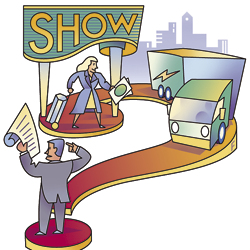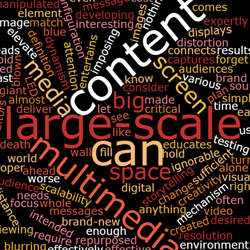|
REGISTRATION REQUIRED
research
Tech Knowledge
According to the results of our 2018 Marketing Technology Survey, the use of exhibit- and event-related tech has risen slightly in the past two years. Today's marketers are using everything from touchscreens to augmented reality to boost brand awareness, enhance interactions, and increase sales. By Travis Stanton
Technology is essentially omnipresent in our everyday lives. From Wi-Fi and Radio Frequency Identification (RFID) to Bluetooth-enabled devices and Near-Field Communication (NFC), we are actively and passively engaging with technology nearly every second of every day – oftentimes without even realizing it. In other words, technology has become less about gadgets and gizmos and more about connectivity to everything that's essential to live our lives and do our jobs.Technology is essentially omnipresent in our everyday lives. From Wi-Fi and Radio Frequency Identification (RFID) to Bluetooth-enabled devices and Near-Field Communication (NFC), we are actively and passively engaging with technology nearly every second of every day – oftentimes without even realizing it. In other words, technology has become less about gadgets and gizmos and more about connectivity to everything that's essential to live our lives and do our jobs.
As such, it's not surprising to see technology making an increasingly apparent impact on the face-to-face marketing industry. But how, specifically, has tech impacted trade shows and events? And are exhibit- and event-related applications of technology driving tangible, measurable results, or are they merely gimmicks employed to grab attention. To find out, we fielded the 2018 Marketing Technology Survey, the fifth iteration of what has been an eight-year initiative to track the adoption and use of exhibit- and event-related technologies along with their associated costs and benefits. This year's survey queried representatives from nearly 200 companies about everything from which technologies they're currently incorporating into their exhibits and events to what corporate objectives, if any, those technologies are helping them achieve. And when compared to benchmarks established via our 2010, 2012, 2014, and 2016 surveys, the results indicate that tech usage is on the rise. According to this year's survey results, 96 percent of respondents currently use technology to enhance their marketing efforts in some way, with 84 percent employing various technologies inside their trade show exhibits and 54 percent incorporating technology into their companies' corporate events. Compared to 2016, that marks a 5-percent increase in the number of companies using technology to enhance their exhibits, whereas event usage has only increased 3 percentage points in the past two years. Interestingly, a drop in tech usage occurred between 2014 and 2016, and today's metrics are essentially on par with adoption rates measured in 2014. The data also implies that companies that are incorporating marketing-related technologies are dipping their toes deeper into the techno tidal pool than they were in the past, adopting multiple technologies as opposed to one or two applications at a time as they were doing back in 2010. The technologies that have shown the most noticeable growth in exhibit- and event-related usage since 2016 include mobile apps, smartphones, geofencing, and virtual reality – all of which experienced growth rates of 50 percent or more. The use of event-specific microsites, tablet PCs, touchscreens, augmented reality, digital signage, and streaming video has also increased. However, some technologies appear to be on the decline, such as personal URLs (PURLs). Meanwhile, usage of Quick Response (QR) codes, projection technology, and virtual events has remained statistically unchanged since 2016. Survey results also indicate the use of RFID and audience response systems is poised for significant growth, as a high volume of respondents reported actively considering their implementation for 2019. Respondents who have used various technologies in the context of their exhibit- and event-marketing efforts indicate that those technologies have led to increases in booth traffic, brand awareness, and sales leads, as well as improved relationships with clients and enhanced staffer/attendee interactions at trade shows and events. And while less than a quarter of exhibit managers who have used technology to enhance their trade show exhibits proactively set measurable goals to gauge the effectiveness of those applications, the vast majority (72 percent) report that the technologies they used met or exceeded initial objectives. For more information on EXHIBITOR's research projects, visit www.ExhibitorOnline.com/Research. 
|
|
|
||||||||||||||||||||||||||||
|
|
||||||||||||||||||||||||||||
|
TOPICS Measurement & Budgeting Planning & Execution Marketing & Promotion Events & Venues Personal & Career Exhibits & Experiences International Exhibiting Resources for Rookies Research & Resources |
MAGAZINE Subscribe Today! Renew Subscription Update Address Digital Downloads Newsletters Advertise |
FIND IT Exhibit Producers Products & Services All Companies Get Listed |
EXHIBITORLIVE Sessions Exhibit Hall Exhibit at the Show Registration |
ETRAK Sessions Certification F.A.Q. Registration |
EDUCATION WEEK Overview Sessions Hotel Registration |
CERTIFICATION The Program Steps to Certification Faculty and Staff Enroll in CTSM Submit Quiz Answers My CTSM |
AWARDS Exhibit Design Awards Portable/Modular Awards Corporate Event Awards Centers of Excellence |
NEWS Associations/Press Awards Company News International New Products People Shows & Events Venues & Destinations EXHIBITOR News |
||||||||||||||||||||
|
||||||||||||||||||||||||||||






